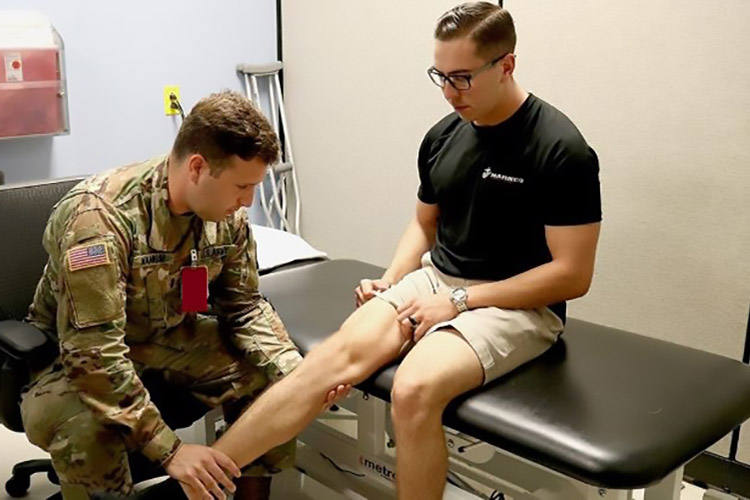Surveillance snapshot: Illness and injury burdens, reserve component, U.S. Armed Forces, 2021
 Army 1st Lt. Nicholas Wankum, a physical therapist at Madigan Army Medical Center, evaluated the progress Marine Staff Sgt. Dalton Everhart made in his range of motion since the recruiter came to the emergency department after an injury nearly a month before this September 2019 visit (U.S. Army photo).
Army 1st Lt. Nicholas Wankum, a physical therapist at Madigan Army Medical Center, evaluated the progress Marine Staff Sgt. Dalton Everhart made in his range of motion since the recruiter came to the emergency department after an injury nearly a month before this September 2019 visit (U.S. Army photo).
You also may be interested in...
Article
Nov 1, 2023
Reportable Medical Events are documented in the Disease Reporting System internet by health care providers and public health officials throughout the MHS.
Article
Nov 1, 2023
Continuous surveillance is essential to prevent cold weather injuries and mitigate their adverse impacts on military operations.
Article
Nov 1, 2023
Common respiratory viruses are associated with substantial morbidity within the MHS.
Article
Nov 1, 2023
This report describes recent frequencies and rates of clinically-diagnosed sunburn among active component service members of the U.S. Armed Forces.
Article
Nov 1, 2023
The U.S. Advisory Committee on Immunization Practices recommends influenza vaccination for all health care personnel, including MHS staff, to protect both themselves and their patients.
Article
Oct 1, 2023
The emergence of mutant P. falciparum parasites in many malaria-endemic areas has led to false-negative results in all HRP2-detecting rapid diagnostic tests, undermining their critical utility, especially in deployment settings.
Article
Oct 1, 2023
Complete and timely reporting of notifiable medical conditions among the Department of Defense (DOD) beneficiary population is important for the control of communicable and preventable diseases and injuries.
Article
Oct 1, 2023
This report describes the incidence rate of colorectal cancer among active component U.S. military service members between 2010 and 2022.
Article
Oct 1, 2023
Reportable Medical Events are documented in the Disease Reporting System internet by health care providers and public health officials throughout the Military Health System.
Report
Oct 1, 2023
 .PDF |
1.29 MB
.PDF |
1.29 MB
The October 2023 Medical Surveillance Monthly Report (MSMR) provides a review of the incidence of colorectal cancer among active component service members from 2010 to 2022; followed by a study of force protection risks in AFRICOM, INDOPACOM, and SOUTHCOM due to rapid diagnostic test failures for P. falciparum malaria from 2016 to 2022; then an update ...
Article
Sep 1, 2023
Reportable Medical Events are documented in the Disease Reporting System internet by Military Health System providers and public health officials to monitor, control, and prevent the occurrence and spread of diseases of public health interest or readiness importance.
Article
Sep 1, 2023
This report provides an update through June 2023 of routine screening results for antibodies to HIV among members of the U.S. military. From January 2018 through June 2023, approximately 7 million U.S. military service members (active component, reserve component, and national guard) were tested for HIV antibodies; 1,502 were identified as HIV ...
Article
Sep 1, 2023
This Surveillance Snapshot presents the incidence of the 10 leading cancers among active component service members of the U.S. Armed Forces diagnosed from January 2018 through December 2022.
Article
Sep 1, 2023
This is the first known study examining the rates of seropositivity for Ross River virus in a naïve U.S. Military population prior to an outbreak event, which identified a single seroconversion out of 628 deployed U.S. servcie members tested.
Report
Sep 1, 2023
 .PDF |
1.30 MB
.PDF |
1.30 MB
The September 2023 MSMR provides the annual update of routine screening for antibodies to HIV among the active and reserve components of the U.S. Armed Forces; followed by a serological survey of Ross River virus (RRV) infection among U.S. Marine expeditionary forces who train in Australia; followed by a Surveillance Snapshot of the 10 leading ...
You are leaving Health.mil
The appearance of hyperlinks does not constitute endorsement by the Department of Defense of non-U.S. Government sites or the information, products, or services contained therein. Although the Defense Health Agency may or may not use these sites as additional distribution channels for Department of Defense information, it does not exercise editorial control over all of the information that you may find at these locations. Such links are provided consistent with the stated purpose of this website.
You are leaving Health.mil
View the external links disclaimer.
Last Updated: July 11, 2023